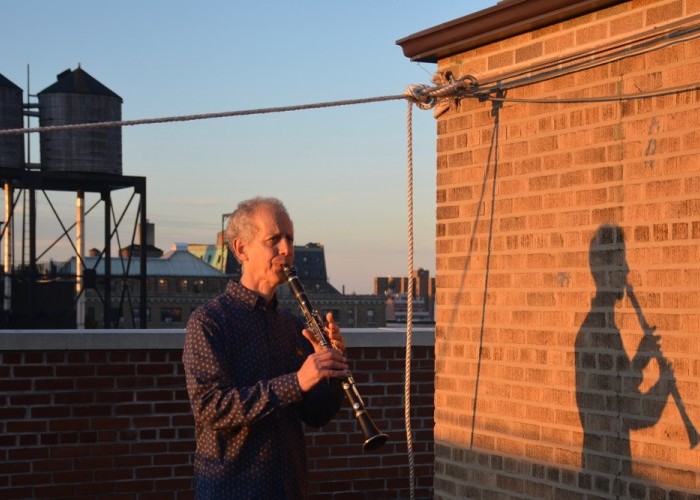Apr 2, 2024 12:59 PM
Saxophonist, Sonic Explorer Casey Benjamin Dies at 45
Casey Benjamin, the alto saxophonist, vocalist, keyboardist and producer who stamped his distinctive sounds on the…

Clarinet player and composer Andy Biskin released his first recording with 16 Tons in June.
(Photo: Amal Biskin)Colleagues balked at clarinet player and composer Andy Biskin’s plan for a project featuring three trumpets, drums and a clarinet. But the artist persisted.
In 2015, Biskin assembled 16 Tons with drummer Rob Garcia and trumpet players John Carlson, David Smith and Kenny Warren. Together, the instrumentalists descended upon a dozen selections from The Folksongs Of North America, published by Biskin’s late mentor and colleague, noted ethnomusicologist Alan Lomax. Biskin’s admittedly scant written arrangements suggested a blueprint for the band to work out fresh ideas on familiar themes, intercutting new and existing melodies, exploring stark rhythmic figures and tensions on what would become Songs From The Alan Lomax Collection (Self Release).
The following has been edited for length and clarity.
How did you approach arrangements that seem to deal deliberately with repetition and patterns present in these kinds of songs?
Some have a call-and-response pattern built into them. This ancient way of organizing music, with a singer and a chorus, gets used in jazz as well, so it seemed like a logical [approach]. I wanted to have a soloist, which is the clarinet, that would be distinct from a chorus. And I wanted the chorus to sound like a chorus, so I decided on trumpet. Two trumpets sounds like three; three sounds like 10—it’s kind of magic.
How did the trumpets and drums inform comping choices?
There are a couple of sections where there’s an improvised line [plus] backgrounds—a tried-and-true jazz arrangement technique. [To avoid] balance issues when the clarinet was soloing, the trick was to try to have the trumpets interject little phrases then leave space, but the phrases would have to give the listener an idea of where you were in the song—or some commentary. I would try to sort of pose a question in the solo and let them answer it in the comping.
The sound of a soloist with just drums became a really fun thing to use. Rob is such a great drummer that your ear would fill in the rest of the rhythm section. The comping could simulate a little big band.
In post-Ornette jazz, comping has become kind of an optional thing. A lot of times when I hear a piano player comping, I think, “I guess he’s adding something, but if he didn’t do anything, would it really be worse?” Comping is fun, but I don’t think it’s essential.
Did the vocal lineage of these songs influence the qualities of lamentation on some of the trumpet parts?
The trumpets are like a foreign tribe. They understand each other more than they understand me or I understand them. I would just throw stuff at them, and they would work it out. It was fun to watch the arrangements evolve through a collective process. [In the] jazz tradition, the whole idea is that you find a voice on your instrument, and you have a sound that is your sound alone. You’re trying to interpret the song the way a singer might.
These songs had no corresponding charts before Alan published them; do you think writing charts inherently alters artistic context?
It’s part of the creative process to take things that are in the air; these are raw materials. My goal was to see if I could use these songs as a point of departure for my own music. After a while, you reach a certain momentum when you’re composing or arranging. You’re no longer arranging “Blue Tail Fly”; you’re just in the middle of a composition. In almost every tune, there was some other melody I would kind of dream up that I would intercut with the tune’s melody, [which offered] tension.
These anthologies existing is sort of a weird idea. There are these little piano arrangements—chord symbols, treble clef, 4/4 time, eighth notes—but I would have no idea what the song was about by looking at [them]. I used the printed paper to decide if I was even interested in the song, then I would try to find actual performances.
These versions have lives of their own after they get written down and recorded. Take “Tom Dooley”; the Kingston Trio version has very little to do with the original. It’s been sanitized and laundered; it’s almost a joke. All the life has been sucked out of it. But that’s the version that was the number-one best seller and on The Ed Sullivan Show.
You’ve traced certain selections to their European countries of origin. Regarding the ones created in the U.S., have you been able to trace origins of melodic figures or rhythmic patterns to African countries or regions?
No, but I’ve certainly looked at books about the African origins of the blues. [My work with Alan] was figuring out what was unique about a certain music culture, then comparing different music cultures, and correlating a culture’s music to social structure and the way people lived.
When you sit down to do something, everything you’ve soaked up in your life gets called into play. Part of the creative process is that things just kind of bubble up from your unconscious. You wake up one day and hear something a certain way, and you write it down before you forget it. I would just play these tunes and improvise, and see what would pop up. You want to be as free and spontaneous as possible. DB

Benjamin possessed a fluid, round sound on the alto saxophone, and he was often most recognizable by the layers of electronic effects that he put onto the instrument.
Apr 2, 2024 12:59 PM
Casey Benjamin, the alto saxophonist, vocalist, keyboardist and producer who stamped his distinctive sounds on the…

Albert “Tootie” Heath (1935–2024) followed in the tradition of drummer Kenny Clarke, his idol.
Apr 5, 2024 10:28 AM
Albert “Tootie” Heath, a drummer of impeccable taste and time who was the youngest of three jazz-legend brothers…

“Both of us are quite grounded in the craft, the tradition and the harmonic sense,” Rosenwinkel said of his experience playing with Allen. “Yet I felt we shared something mystical as well.”
Mar 12, 2024 11:42 AM
“There are a few musicians you hear where, as somebody once said, the molecules in the room change. Geri was one of…

Henry Threadgill performs with Zooid at Big Ears in Knoxville, Tennessee.
Apr 9, 2024 11:30 AM
Big Ears, the annual four-day music celebration that first took place in 2009 in Knoxville, Tennessee, could well be…

“I’m also at a point in my life where I don’t feel like I have anything to prove, like at all,” Akinmusire says about his art.
Mar 26, 2024 12:45 PM
At the risk of oversimplifying and romanticizing the story, Ambrose Akinmusire came bursting on the jazz scene at the…